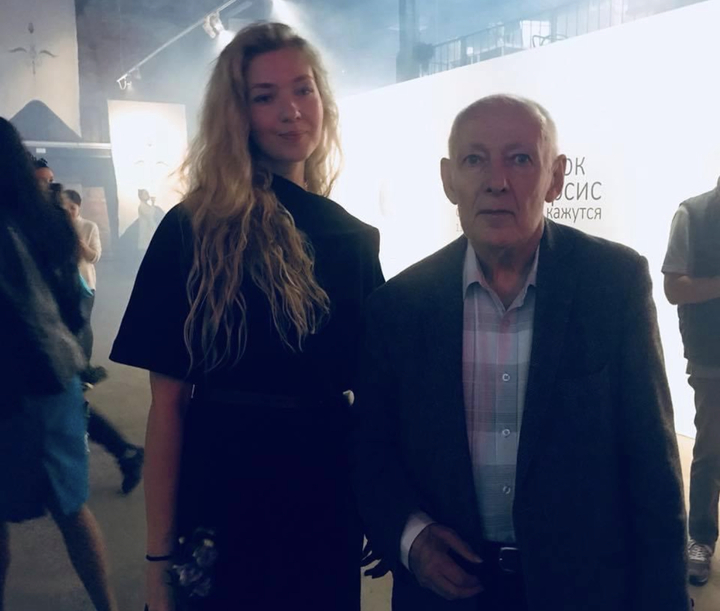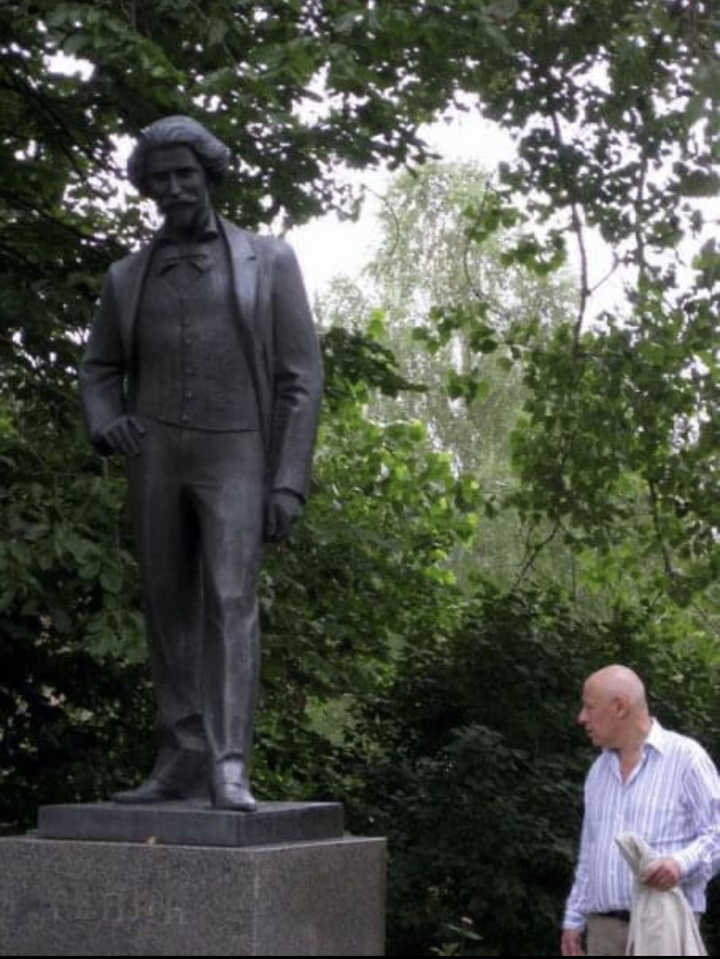The phenomenon of the deceased art critic Backstein: he knew how to be listened to
[ad_1]
Joseph Markovich Backstein was born in Moscow in 1945. Since childhood, he was friends with Vladimir Paperny, Alexander Melamid and Vitaly Komar – who would later become innovators of the art scene, creators of social art. But I went to the physics department, to the Moscow Institute of Electronic Engineering. Then he worked as an engineer in scientific institutes for more than 20 years. How did the techie degenerate into a highly cultural unit?
This happened in the 1980s. Backstein entered graduate school at the Institute of Sociology of the Russian Academy of Sciences, where he wrote his PhD in philosophy, and began organizing exhibitions of young independent art. In 1987, he became the executive director and curator of the first registered association of unofficial artists in the USSR – the “Club of Avant-garde Artists” (KLAVA). The president of the society was the poet Dmitry Prigov, the chairman was the artist Boris Matrosov, and it included Ilya Kabakov, Nikita Alekseev, Sergei Anufriev, Andrei Filippov. Sven Gundlach, Elena Elagina, Vadim Zakharov, Igor Makarevich, Andrei Monastyrsky, Irina Nakhova, Dmitry Prigov and the poet Lev Rubinstein, who passed away immediately after Joseph Markovich – the next day. The association gathered around itself everyone who has entered the history of modern art today, and its main driver was the active Backstein. It turned out that KLAVA was both a parody of Soviet-era creative unions and a daring artistic project. Backstein moved exhibitions from apartments and workshops to the streets, bathhouses, prisons, zoos – and they inevitably became high-profile public events. Today, most often remembered are Backstein’s projects in the Sandunov Baths and Butyrka Prison, but these are only a couple of bright pages in a series of actionist marches that turned the situation around in the art of perestroika times. “Rally of fatal passion”, “Vertical take-off”, “Volga flows into the Baltic Sea” – these are a few actions from a long list that, if they do not speak for themselves, then eloquently hint at something new, daring, postmodern. The new avant-garde artists aroused great interest at the first, now famous, Moscow Sotheby’s auction, which not only had a beneficial effect on the artists’ pockets, but also made them famous and opened the way to the foreign stage. And Backstein brought them out of hiding and showed them to the world.
Even before the collapse of the USSR, Joseph Markovich curated the exhibition in West Berlin “Art: Moscow-Berlin” in 1988 and the grandiose “Between Spring and Summer. Soviet conceptual art in the era of late communism” in Boston. And in 1992 he founded the Institute of Contemporary Art in Moscow – with its own educational program, polar with the academic one. The Institute has already raised a generation of theorists, curators and artists. Students often came there with an existing classical education – for a different vision, modern, living, meaningful.
More than 10 years later, the Moscow Biennale of Contemporary Art was born. It was invented by the practitioner Backstein together with the theorist Victor Misiano – the biennale became a phenomenon in the 2000s. The first and second art shows covered almost all the capital’s venues with contemporary art, and they were all united by a common theme, idea, message – this had never happened in Russia before. The idea was to turn Russia into one of the main cultural points of the world. For this purpose, they called the stars of the curatorial business – Harald Szeemann, Hans Ulrich Obrist, Germano Celant and Robert Storr, and raised their own. Just imagine: at the first biennale, which took place in Moscow in 2005, one of the most important artists of our time, Christian Boltanski, video art icon Bill Viola and the legendary conceptualist, one of Backstein’s closest friends, Ilya Kabakov, were simultaneously shown.

Joseph Markovich remained commissar until 2017, but the more his strength left him, the less energy he had in the grandiose task he had planned. This is how Tatyana Sherstyuk, his student and conceptual artist, remembered Joseph Backstein.
“I still can’t get over the news about the death of Joseph Markovich. I remember the first meeting with him. He was on the selection committee – serious, attentive, ironic. In Vyshny Volochyok there was a summer internship for students of the Institute of Contemporary Art. And on the very first evening of practice, the students went swimming in the river. Joseph Markovich is with us. I decided to show everyone my class and did a handstand. He was already at a decent age then, but he did complex yoga asanas. Everyone started repeating after him. Try to stand up on your hands. He could stand on one. It was impressive. Such physical preparation! Of course, no one could repeat it correctly – everyone fell, and Joseph rushed to swim down the river.
***
– Joseph knew how to make himself heard and listened to. One day we needed to discuss the exhibition, and we went to a cafe next to Kabakov’s studio. We sat down at the table, but it was impossible to talk, as the music and noise drowned out the voices. We moved to another table, and then Joseph turns into the depths of the hall and says in his commanding voice: “Why so loud! Make it quieter!” The music was turned off immediately. A crowded cafe, full of people, and he said this to nowhere, and complete strangers listened, and immediately stopped making noise.
***
– I’ve been to his birthdays several times. These were always social events that everyone wanted to attend. We always called each other on birthdays. Until last year. I can imagine how many students called and wrote to him. It’s surprising and pleasant that he remembered me.
***
– I owe him my understanding of the importance of the context of art. My first higher education was in classical art, and I was familiar with many Soviet artists who, at the beginning of the 2000s, vegetated in studios, painting still lifes. All this was no longer relevant and no one needed it. And the institute constantly attracted new progressive curators and lecturers, expanding our horizons. This is a serious contribution.
***
– Joseph Markovich could give a comment that changed your view of what you see.
I owe him my first exhibition after graduation. I had the concept in mind for a long time. I discussed it with friends and artists. It was necessary to understand in which direction to move. Joseph gave valuable advice and introduced him to Asya Filippova, who invited her to make an exhibition at the Fabrika Center for Contemporary Art, where it took place.
***
– He loved to be among young people. Until recent years, when he no longer felt very well, he went to all the openings. He appeared surrounded by young students. Under the arm. I remember once saying “they say I have such a catchy look” and smiled. He looked conspiratorially, expressively.

***
– No matter what anyone says, Joseph is not a person, but an era. And even if it sounds pretentious, but such a scale of personality. She turned around the callous situation that existed after the collapse of the USSR. He attracted a new generation, which received recognition both in Russia and abroad. He raised a whole galaxy of artists and curators. There is no person who would have a neutral opinion regarding him. The same Institute of Contemporary Art has either bright fans or tough opponents. There is no third. There are no indifferent people.
***
– Once at the Venice Biennale we spent the whole day running around the exhibitions. It was necessary to transfer from ferry to ferry in order to catch the opening with Anatoly Osmolovsky. And now we’re late. Joseph, as always, with a large black backpack. Everyone knows this famous backpack of his. He rushed – “Tanya, run after me!” – and run across the entire island. And so we jump on the ferry, and I say with laughter: “Joseph Markovich, now you can officially say that I was running after you!”
***
– Everyone knows Joseph as a famous curator and art critic, but not everyone knows that he played in theater and cinema. Joseph, by the way, was proud of this. I remember once boasting: “I played a role in Valeria Gai Germanika. And like this – look what I’m like there…”
The film that Tatyana Sherstyuk mentions became very personal for Guy Germanika. It was filmed 10 years ago (the premiere took place at the Hong Kong International Film Festival in the spring of 2014), but the events clearly take place earlier – in the dashing 90s. “Yes, yes” is something between a fairy tale and a hallucinogenic dream to the music of the groups “Picnic” and “Agatha Christie”.
Sasha, a primary school teacher, quarrels with her family over nonsense and goes to an underground artist’s party. While drinking, she meets Antonin and a romance begins. Then the young man becomes ill and is taken away in an ambulance. Art critic and curator Joseph Backstein appears precisely at this turning point: in a white doctor’s coat and glasses. He, in the role of a doctor, reports: Antonin needs urgent kidney surgery and it costs 36 thousand. Sasha doesn’t have that kind of money, moreover, her passport is damaged because there’s a picture on it, and she can’t get a quota either. This pushes Sasha to creativity: she first walks around the room for a long time, and then frantically begins to write on the canvas with everything that comes to hand. The desire to raise money for an operation for her lover changes her and turns her into an artist. The serious diagnosis was not confirmed, she left her boyfriend, but her creativity remained with her. In the finale, the artist is in front of a white canvas – in front of her is a white “nothing”, along which she stiffly begins to move her finger in the white paint…
The film was criticized for the simplicity of the plot, the frivolity and even stupidity of the characters, for the ending, where the hallucinogenic “lens” through which we saw all previous events disappears. At the same time, they were praised for the skill of the operators, focus on details, and subtle psychophysics. He left no one indifferent. Just like the doctor, who became the key that opened the door to art for a young impulsive girl.
The footage with Joseph Backstein is a kind of rebus. It seems like an episode – the doctor coldly and cynically tells the heroine something terrible – but it is he who turns her life upside down. The same thing happened to him in reality – his student testifies – a fleeting word could change his view, his fate, his society. This was the case with exhibitions, with the Moscow Biennale and the Backstein School. This is how it was in everyday life for this philosopher with enormous practical talent. “There is no beginning and no end, let’s paint life in all colors,” this is how Guy Germanicus ends his parable-fairy tale with a yes-yesist title…
Farewell to Joseph Backstein will take place on Friday, January 19 from 10.00 to 11.00 in the farewell hall at the Vostryakovsky (South) cemetery, on Ozernaya Street.
[ad_2]
Source link






